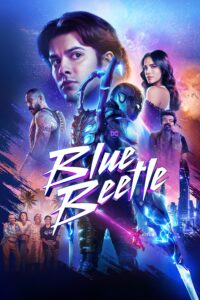
ANIMO!: Religious Notes on "Blue Beetle"
 The religious imagery in the movie Blue Beetle is arguably the most overt I have seen in a superhero movie.[i] This is so interesting because religious imagery is almost non-existent in the comic book series. One of my favorite parts of this movie arises in the character of Nana (who I would call Welita in my life – yes with a “W”) and others may call abuela. For years I have claimed that I am an abuelita theologian in training. I have taken the attributes of my own grandmothers as well as other elders who have mentored me and combined them into a nebulous image of what that means. Nana Reyes in the movie Blue Beetle is incredibly close to my imaginative conjuring. Yara González-Justiniano lists the grandmother trope as a “Feminist Theme” and claims, “The cultural and ethnic representation hint[s] at the untold stories of Latinx in US mainstream history, specifically, around military opposition and revolutionary movements. In the movie there is a breaking of the sweet abuela trope, … adding texture to the matriarchs that build these families and the layered histories of relationship to the US and Latin American countries of origin.”[ii]
The religious imagery in the movie Blue Beetle is arguably the most overt I have seen in a superhero movie.[i] This is so interesting because religious imagery is almost non-existent in the comic book series. One of my favorite parts of this movie arises in the character of Nana (who I would call Welita in my life – yes with a “W”) and others may call abuela. For years I have claimed that I am an abuelita theologian in training. I have taken the attributes of my own grandmothers as well as other elders who have mentored me and combined them into a nebulous image of what that means. Nana Reyes in the movie Blue Beetle is incredibly close to my imaginative conjuring. Yara González-Justiniano lists the grandmother trope as a “Feminist Theme” and claims, “The cultural and ethnic representation hint[s] at the untold stories of Latinx in US mainstream history, specifically, around military opposition and revolutionary movements. In the movie there is a breaking of the sweet abuela trope, … adding texture to the matriarchs that build these families and the layered histories of relationship to the US and Latin American countries of origin.”[ii]
Twice before in the movie when other characters mention fighting, Nana calmly, quietly, with her trenzas raised, says it is not time. She comes across as a passive and unknowing grandmother. She is quietly sewing and listening to her Walkman when the scarab chooses Jaime and begins to transform him. However, when Jaime is most in need and it seems that the Blue Beetle superhero has lost all hope, the matriarch warrior nod to the adelitas Nana drops her trenzas and says this important phrase, “We have turned both cheeks. Now we fight.” This is a direct allusion to Matthew 5:39--“But I say to you, Do not resist the evildoer. But if anyone strikes you on the right cheek, turn the other also.” Biblical scholars claim that the author of the Gospel of Matthew is using hyperbole in this entire passage, which reads
You have heard that it was said, ‘An eye for an eye and a tooth for a tooth.’ But I say to you: Do not resist an evildoer. But if anyone strikes you on the right cheek, turn the other also, and if anyone wants to sue you and take your shirt, give your coat as well, and if anyone forces you to go one mile, go also the second mile. Give to the one who asks of you, and do not refuse anyone who wants to borrow from you. (5:38-42)
In reading this passage as hyperbole one sees a power play, in that turning the other cheek is an unexpected move from the aggressor’s perspective. Up to this point in the movie, Jaime has used these unexpected moves when he is resisting the scarab’s desire to kill and Jaime’s freewill overtakes the power of both the aggressor and the scarab.
In Nana’s phrase, “We have turned both cheeks. Now we fight,” an interpretation can be seen from the Gospel of Matthew’s use of the word “you” in this passage, “But I say to you: Do not resist an evildoer. But if anyone strikes you on the right cheek, turn the other also.” To be honest, every time I have heard or read this passage in Matthew prior to watching Blue Beetle, I have always imagined an individual aggressor slapping an individual person, humiliating and dehumanizing them. However, Nana says, “WE.” “We have turned both cheeks.” Woah! What? Que? Como? Que cambio aquí? We? She mentions a collective. In her warrior, militant, fighter-against-injustice mode, Nana foregrounds the collective. In highlighting the collective, she is not only underscoring the fight of the family to save Jaime, she engulfs all of the injustices perpetuated against her peoples for centuries – genocide, culturecide, epistemocide, lingocide, colonization, servitude, enslavement, racism, sexism…. Nana’s words are not a simple allusion to the Gospel of Matthew but a response as a rally call to live out the Gospel. To fight for justice.
Nana’s words marshal us to work collectively for a greater possibility. She does not romanticize anything either. Her son was killed in an earlier scene in the movie. The family has lived in a perpetual state of fear due to documentation status unrecognized by the imagined national government. Their drive home includes a left turn on El Paso street in front of a series of pink crosses, a nod of remembrance of the 23 killed and 22 injured in the El Paso massacre of 2019. Wooden crosses such as these exist across the country remembering those who have died too young. Some of these crosses include those placed for migrants who have died in the path toward a better life, crosses placed for farm workers who have died too young from chemical sprays and brutal work, and so many more. The color pink of the crosses seems to be simply so they stand out behind the street sign.
The sociocentric pueblo on a journey open to the Spirit synodal call of Nana can also be seen in another phrase repeated through the movie: “Animo.” It sometimes appears alone like the Milagros’ beautiful street art on the front of the Blue Beetle ship. It also appears in the phrase, “Animo. WE can do this!” Here you could make a bit of a Marianist leap to Mary’s “Yes.” The Marianist Charism has a strong basis in Mary’s response to the Angel Gabriel’s invitation to play a particular role in the Incarnation of God, the Second Person of the Trinity, Jesus. I do recognize that I am taking a little creative license, jumping Gospels to make my point. Yet, let’s think for a moment that in the phrase “Animo, We can do this!” not only has the family heard Nana’s response to the Gospel of Matthew as a rally call, they have also responded with mutual affirmation to their collective yes responses.
Speaking of Mary, the imagery of Nuestra Señora de Guadalupe is rampant. The largest of the many shrines in the Reyes house is one dedicated to La Guadalupana. This image literally takes center screen when Jaime is morphing into Blue Beetle and aligns eyes with the Guadalupan image. Much has been said about the eyes of Guadalupe, including what seems to be a reflection of Juan Diego and the bishop in her cornea. I do wonder about the use of this image to point to questions of mestizaje. Could the connection between Jaime’s and Guadalupe’s eyes be a recognition of the complexities of the blendings and intermixings of humans which carry a colonial violence, as is the case with the scarab taking over Jaime’s body? The voice of the beetle appearing just as Jaime is recognizing what is happening to him makes me ponder the different ways of interpreting this scene. Could this scene be pointing to large issues between religion and science which are often read as being diametrically opposed?
Tío Rudy is both comedic trope and nerd. He is a new embodiment of the chapulín while also creating his own chapulín. He wavers between being a conspiracy theorist and truth-teller. So many of us have a Tío Rudy. My Tío Rudy’s name is José Pepe Joe Melendez. He was my mom’s youngest brother. He died in May of this year at far too young of an age. He spent his life as a semi-truck driver, a gadget collector, and a fiddler with many things electronic and mechanical. When I was young, his room at my grandmother/Godmother’s house looked like a mix between Radio Shack and a pawn shop. I remember him driving up to our house with that same la cucaracha horn! Rest in power, Uncle Joe! Tío Rudy also has a Guadalupe tattoo and is the wisdom leader and knowledge-bearer. He informs the younger generation of the history of El Chapulin and Blue Beetle as well as includes the references to Lucha Libre. Oh, the multiple masks of Mexicans and Mexican American imaginations![iii]
Speaking of truth, Milagros declaration to her family – “He’s had his tacos, let him have the truth” – stood out to me, as someone who was the first in her giant extended family to go away to college, to this very beautiful place of St. Mary’s University. All of the way through my education, my family withheld information from me so I would not worry and do poorly in my courses. I saw this movie for the first time with my parents in El Paso this summer, and saw it again the very next day just with my dad. When Millie said this line, I let out a “MMMHMM” so loud in the almost-empty theater that the little girl sitting behind us asked her mom if she heard me. In this scene, Jaime had his taste of home literally in his tacos and figuratively with the entire return. Is it cultural to withhold the truth? Is the truth something to be shared only in certain spaces and places? Might there be an intimacy associated with sharing the truth which distance makes difficult?
The family’s last name stands out as a religious symbol – Reyes. Of course this name is plural. It points to the reyes magos (and their camel, like the ones outside of Blume library). Various characters wear jackets with this name. It is the name of the family garage. The reyes magos are the gift bearers in the infancy narrative of Matthew. They are also the protectors. In a dream they learn of Herod’s evil plan and return home a different way so as not to disclose the Holy Family’s location. Also, Christians are baptized as priest, prophet, and king. Finally, because the name is a last name in Blue Beetle, not the singular Rey, it is also gender neutral.[iv]

The gentle ebb and flow the movie uses to raise very difficult issues is among the reasons I have seen this movie at least five times. One theme which arises repeatedly can be extrapolated from the quote, “My name is not Sanchez...” This simple quote infers the theme of higher education mixed with all Latinx as being alike. An unspoken understanding exists that diversity includes one person of every racialized category on the US Census and maybe one of those falls under the umbrella of “Hispanic,” which I have been told (when someone has committed the sin of omission against this generic collective created by the same government), is not a race. Once that quota has been met, diversity has reached the level of excellence. And since everyone is the same within any given category, they must all have the same name – or those in power do not need to learn their name. Such is the case with el Doctor José Francisco Morales Rivera de la Cruz. Please note his name ends with “of the cross.” He is clearly a cross-bearer in making the difficult choices of using his education to better himself and probably the expectation of communal raising. He helps the villainous weapon manufacturer through his own research and knowledge, contributing to necropolitical systems which keep him employed and fed.
I love that the family uses la bendición throughout the movie. My parents are living with us for the next couple of months. Dad had a stroke followed by a brain hemorrhage in May. They came to stay so we can work more collectively between jobs, housework, and therapy. We have all known that he and Mom would be with us these months. What I did not factor into the equation was the cross they would place on my forehead on Tuesday, blessing me for a safe trip and wisdom to share. I am forty-nine years old and my parents still give me la bendición. It’s a sign of care as well as of collectivity. My travels, work, sharing, and caring are an extension of them and of my community. Every time I used to leave El Paso for college, my grandmother/Godmother would make me get on my knees to give me a blessing. She would recite a litany off the top of her head that seemed to invoke the entire communion of saints. She would include as many of our ancestors as she could name and invoke her mother, aunts, and grandmother. I would begin to laugh, which was partially her goal – to turn a bitter moment to bittersweet. That bendición means I may go far and away but I do not go alone. It reminds me not to fear because I stand on the shoulders of giants, of generations of matriarchs and women leaders.
ANIMO! WE CAN DO THIS!
[i] Thank you to Sudabée Lotfian-Mena for the research assistance. For more on the music of the movie Blue Beetle see “Soundtracking ‘Blue Beetle,’” by Sudabée Lotfian-Mena, Hispanic Theological Initiative Open Plaza, November 13, 2023, https://www.htiopenplaza.org/content/sountracking-blue-beetle.
[ii] Yara González-Justiniano, “The Blue Beetle: ‘¡No contaban con mi astucia!’” Feminism and Religion, August 8, 2023, https://feminismandreligion.com/2023/08/24/the-blue-beetle-no-contaban-con-mi-astucia-by-yara-gonzalez-justiniano/.
[iii] As a little side note, I found the connection between the bugs interesting – la cucaracha, el chapulin Colorado, and the Blue Beetle. I actually spent hours doing deep research on this topic and possible connections. For more, see: Ana María Quiceno Vélez, “De Barthes al Chapulín Colorado. Una Lectura de Los Héroes y Antihéroes Como Configuraciones Míticas,” Pontificia Universidad Javeriana, 2010, https://repository.javeriana.edu.co/bitstream/handle/10554/5525/tesis537.pdf ?sequence=1; Rodrigo Cervantes, “What Do ‘Blue Beetle,’ Quetzalcóatl, and Chapulín Colorado Have in Common?” Los Angeles Times, August 14, 2023, https://www.latimes.com/delos/story/2023-08-14/blue-beetle-love-mythical-Heroes; “From Satire to Folk Music, the Symbolism Behind ‘La Cucaracha,’” Nuestro Stories, December 1, 2023. https://nuestrostories.com/2022/09/from-satire-to-folk-music-the-symbolism-behind-la-cucaracha; Víctor Monserrat, “Los Artrópodos En La Mitología, Las Creencias, La Ciencia y El Arte Del Antiguo Egipto,” Boletín de La Sociedad Entomológica Aragonesa, no. 52 (2013): 373–437.
[iv] The rejas – the iron rod designs on the window of the family home are shaped in the Sankofa. This Adinkra symbol of Cote d’Ivoire and Ghana is the heart shape seen in the wrought iron all over San Antonio, New Orleans, and many other parts of the lands we now call America. This symbol is often understood as a bird and interpreted as “Look to the Past to Understand the Present.” Scholars in Louisiana have found in their research that West African enslaved peoples many times interwove these designs into the wrought iron in New Orleans and other cities. Some claim these designs were a means of communication for the enslaved peoples. Most of these people were not paid for their labor and were considered property, often traded within the same streets where they worked and created their wrought iron messages. For more, see: Kaleena Sales, “Beyond the Bauhaus: West African Adinkra Symbols,” AIGA Design Educators Community, https://educators.aiga.org/beyond-the-bauhaus-west-african-adinkra-symbols/; Marcus Christian, Negro Ironworkers of Louisiana: 1718-1900 (Gretna: Pelican, 2002); Sidney Holmes, “Who Built New Orleans?: The Untold Story of Black Blacksmiths,” Very Local, March 4, 2022; Morgan Randall, “The Storytelling Ironwork of New Orleans,” Atlas Obscura, http://www.atlasobscura.com/articles/ironwork-new-orleans-french-quarter-pontalba-adinkra; Christel N. Temple, “The Emergence of Sankofa Practice in the United States: A Modern History,” Journal of Black Studies 41, no. 1 (2010): 127–50, https://www.jstor.org/stable/25704098; Kim Marie Vaz, The “Baby Dolls”: Breaking the Race and Gender Barriers of the New Orleans Mardi Gras Tradition (Baton Rouge: LSU Press, 2013).
Leave a Reply